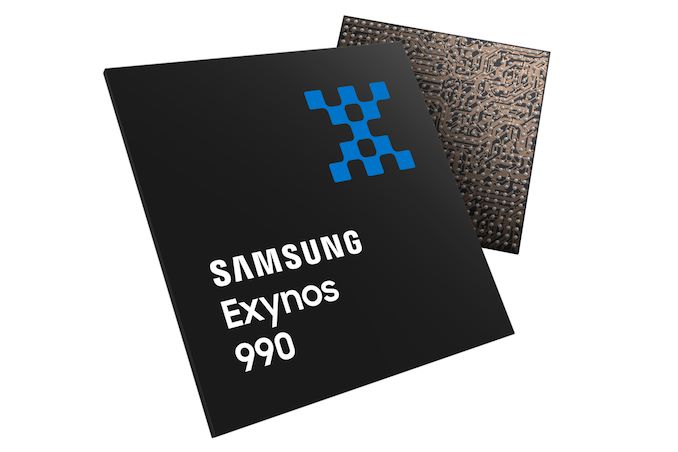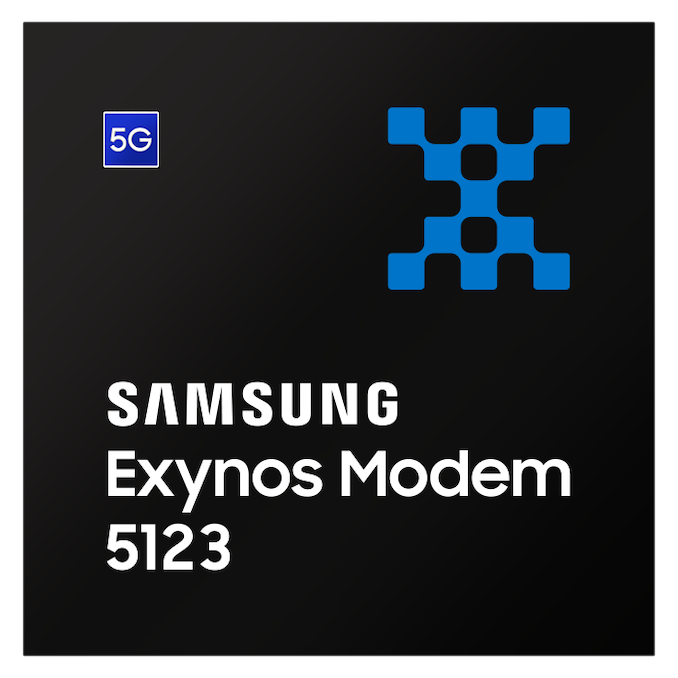Samsung Announces Exynos 990: 7nm EUV, M5, G77, LPDDR5 Flagship SoC alongside Exynos 5123 5G Modem
by Andrei Frumusanu on October 23, 2019 6:00 PM EST- Posted in
- Mobile
- Samsung
- Smartphones
- Exynos
- 5G
- Samsung LSI
- Mali-G77
- Exynos 990

Today Samsung unexpectedly announced the brand new Exynos 990 chipset – likely to be Samsung’s flagship SoC for 2020, employing the newest IP and offering the newest features on the 7nm EUV manufacturing node. The chip closely follows the release of the Exynos 980 earlier in September, and both new silicon chips bring with them 5G connectivity alongside their new product naming scheme.
| Samsung Exynos SoCs Specifications | |||
| SoC |
Exynos 990 |
Exynos 9820 / 9825 |
|
| CPU | 2x Exynos M5 @ ? GHz (+20% perf) 2x Cortex A76 @ ? GHz 4x Cortex A55 @ ? GHz |
2x Exynos M4 @ 2.73 GHz 2x 512KB pL2 3 MB L3 2x Cortex A75 @ 2.31 / 2.4GHz 2x 256KB pL2 4x Cortex A55 @ 1.95 GHz No pL2's 1MB L3 |
|
| GPU | Mali G77MP11 @ ? MHz | Mali G76MP12 @ 702 MHz | |
| Memory Controller |
LPDDR5 @ 2750MHz | 4x 16-bit CH LPDDR4X @ 2093MHz 2MB System Cache |
|
| ISP | Single: 108MP Dual: 24.8MP+24.8MP |
Rear: 22MP Front: 22MP Dual: 16MP+16MP |
|
| NPU | Dual NPU + DSP >10 TOPs |
Dual NPU 1.86 TOPs |
|
| Media | 8K30 & 4K120 encode & decode H.265/HEVC, H.264, VP9 |
8K30 & 4K150 encode & decode H.265/HEVC, H.264, VP9 |
|
| Modem | Exynos Modem External (LTE Category 24/22) DL = 3000 Mbps 8x20MHz CA, 1024-QAM UL = 422 Mbps ?x20MHz CA, 256-QAM (5G NR Sub-6) DL = 5100 Mbps (5G NR mmWave) DL = 7350 Mbps |
Exynos Modem Integrated (LTE Category 20/20) DL = 2000 Mbps 8x20MHz CA, 256-QAM UL = 316 Mbps 3x20MHz CA, 256-QAM |
|
| Mfc. Process | Samsung 7nm LPP (EUV) |
Samsung 8nm LPP / 7nm LPP (EUV) |
|
Starting off with the new CPU complex, Samsung seemingly is continuing with their custom CPU designs for this generation, and we’re seeing the deployment of the new Exynos M5 microarchitecture. Samsung quotes that the new design is 20% faster than the Exynos M4 in the 9820 – a bit of a conservative figure given the larger process node improvement. The new CPU will have to compete against the next generation Snapdragon flagship which most likely will come with Cortex-A77 derived cores which promises 23-30% IPC increases – unless that chip comes with clock degradations, the new M5 will have a hard time competing.
Samsung has upgraded the middle core from the Cortex A75 in the previous generation a newer Cortex A76 design, which should provide a more significant performance uplift in every-day workloads. Finally, we continue to see Cortex A55 cores as the little efficiency cores. Samsung doesn’t disclose the clock frequencies of any of the CPU clusters, but advertises that the overall improvement of the new tri-cluster is 13%.
The Exynos 990 sees a big GPU upgrade in the form of the new Mali-G77 in an MP11 configuration. The new Valhall architecture promises to be a very large performance jump for Arm’s GPU IP, and it looks like the new Exynos will be amongst the first chipsets to employ the new GPU family. Samsung press release claims we’ll see performance uplifts of up to 20%, or power efficiency gains of up to 20%. The increase seems quite meagre given the process improvement as well as the new GPU architecture, it seems very unlikely Samsung will be able to catch up to Apple’s newest chipsets – and Qualcomm is expected to have a big generational jump as well.
One fundamental change that the Exynos 990 brings with itself is the transition from LPDDR4X memory to LPDDR5 memory. This allows the new chipset to increase the memory controller frequency from 2093 MHz to 2750MHz and we’re also expecting the new DRAM technology to bring power efficiency gains to the table.
Samsung discloses that the chip comes with a dual-core NPU and a new DSP which can perform over 10 TOPs in computational throughput – it’s not exactly clear here if Samsung is referring to the DSP’s capability or the combined capabilities of the NPU and DSP. The Exynos 9820’s NPU had a throughput of 1.86TOPs.
Finally, what’s odd here is the chip’s connectivity capabilities: Samsung doesn’t list the Exynos 990 as having modem capabilities which might point out that we’re maybe looking at a pure application processor this generation. Instead of an integrated modem, Samsung is advertising the new Exynos Modem 5123 as a new discrete chipset:
The new modem iterates on the Exynos Modem 5100 used this year: It’s still a complete multi-band solution supporting everything from 2G to 5G sub-6 as well as mmWave, however Samsung has massively upgraded the new chip’s maximum throughput. In regular 4G LTE, the new chip now supports downlink speeds of up to 3Gbps while offering 422Mbps upload. In 5G sub-6, we’re seeing 5.1Gbps downloads, and 7.35Gbps in mmWave networks. The chip’s speeds are enabled by up to 8x carrier aggregation and a new higher-order 1024 QAM, which is as far as we know, the first modem to be announced with such capabilities.
Samsung’s choice of going with a discrete 5G modem this generation seems to be related to the economics of the new silicon: The new 5G modems are still quite large in die size, although the Exynos Modem 5100 was amongst the smallest at 56.03mm². Still, both the new modem as well as the Exynos 990 are manufactured on Samsung’s 7nm EUV node, and separating the two into discrete chips likely makes sense at this point in time in order to offer more flexibility and to increase manufacturing yield.
One question which remains open, is whether Samsung will be opting to pair the Exynos 990 with a different modem than the 5123. Still, it’s unlikely that we’ll see any pairing with a 4G modem, meaning all Exynos flagship devices next year will have 5G support.
Samsung says we’ll see the Exynos 990 in mass production by the end of the year, and we’re likely have the Galaxy S11 being powered by the new piece.
Related Reading:
- Samsung Announces Exynos 980 - Mid-Range With Integrated 5G Modem
- Samsung Announces the Exynos 9825 SoC: First 7nm EUV Silicon Chip
- The Samsung Galaxy S10+ Snapdragon & Exynos Review: Almost Perfect, Yet So Flawed
- Samsung Announces 8nm Exynos 9820 With Tri-Group CPU Design
- Samsung Releases Exynos Modem 5100 - First Multi-Mode 5G Modem











52 Comments
View All Comments
Lodix - Wednesday, October 23, 2019 - link
Very weird product the Exynos 990. Where are you getting the 30% improvement in GPU ? I only see 20% in various Samsung's press releases.I am hoping the European version of the S11 comes with Snapdragon processor if this is what Samsung Exynos can bring. The Snapdragon 865 is supposed to integrate the 5G modem right ?
Andrei Frumusanu - Wednesday, October 23, 2019 - link
We were distributed press releases with 30%. I inquired about the discrepancy and which number would be correct.If the 20% is accurate, then it's absolute garbage in terms of improvements.
Andrei Frumusanu - Wednesday, October 23, 2019 - link
I got confirmation the 20% is correct, RIP.B3an - Wednesday, October 23, 2019 - link
Yeah that's embarrassing. Samsung SoC's have been going downhill since atleast the S9 now (i had to get the Snapdragon import).And maybe update this part:
"The new Valhall architecture promises to be a very large performance jump"
Because it's obviously not a "very big" performance jump and i was like WTF when i read 20%.
Andrei Frumusanu - Wednesday, October 23, 2019 - link
It was *meant* to be a big jump: https://www.anandtech.com/show/14385/arm-announces...The fact that it doesn't look to pan out is a disappointment.
Kishoreshack - Wednesday, October 23, 2019 - link
When is the Note 10 plus review coming?Andrei please do a display analysis of Asus Rog Phone 2
BlakeBB - Thursday, October 24, 2019 - link
"Big Jump" is for Samsung what "Great Leap" was for China.haukionkannel - Thursday, October 24, 2019 - link
Then most likely Samsung did put that 10% to improve the effiency. You normally get either 30% more speed or 30% less power usage. It seems that Samsung did go to 20% more speed and 10z less powerusage. Sensible because their own chips have normally been more power hungry than snapdragons.s.yu - Thursday, October 24, 2019 - link
It's almost never advertised like this. Unless this is some sort of transition half-cycle and the next Note will be on something faster to be released next year it looks like almost zero improvement compared to the 9825 which was just a node bump. How does anybody in the ARM space manage single digit improvements on a hardware generation?levizx - Friday, October 25, 2019 - link
Yet it's physically impossible to have 20% more performance OR 10% less power. You'll have to lower the frequency and bump UP the voltage. The power saving MUST be higher than performance gain if it's a trade off.